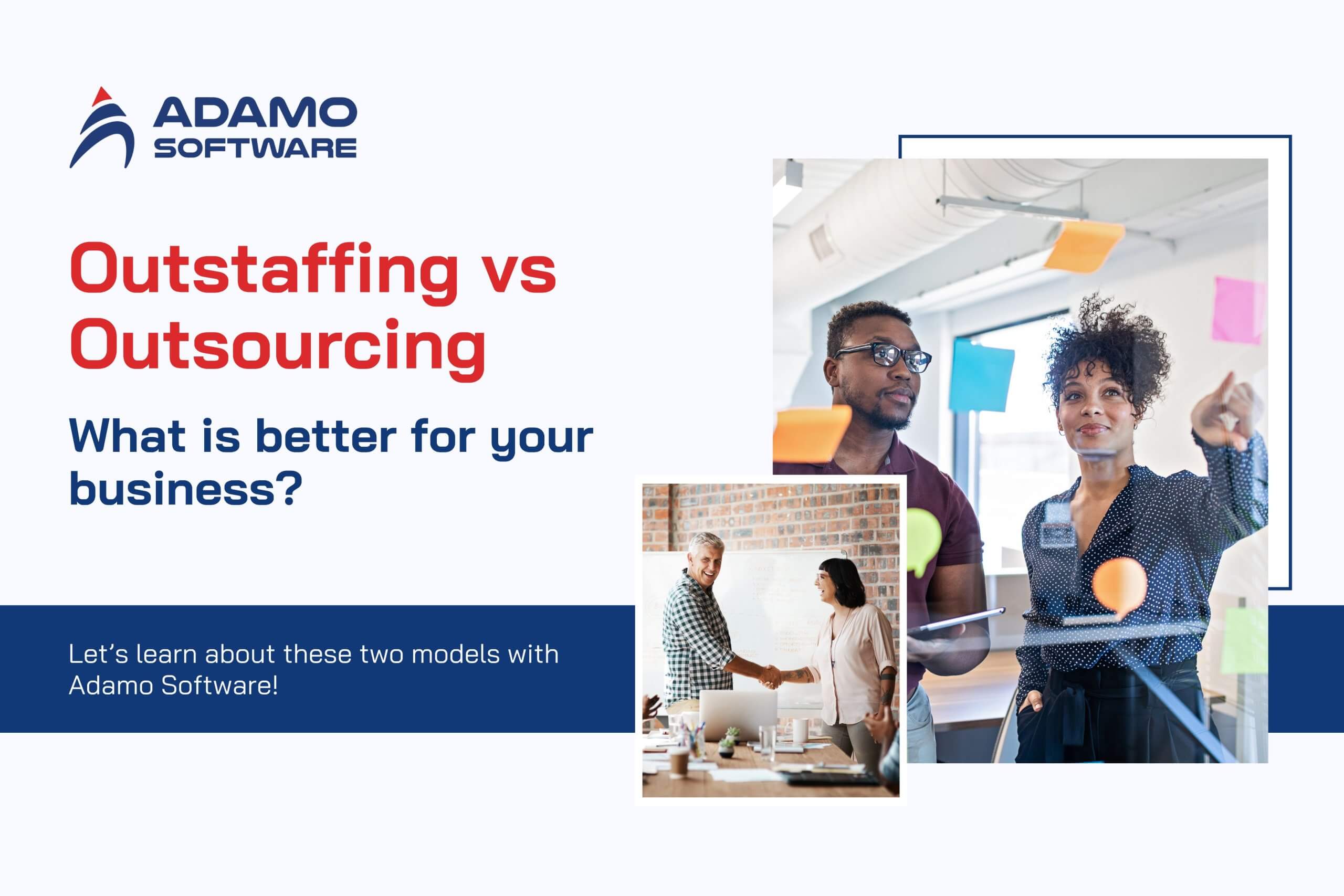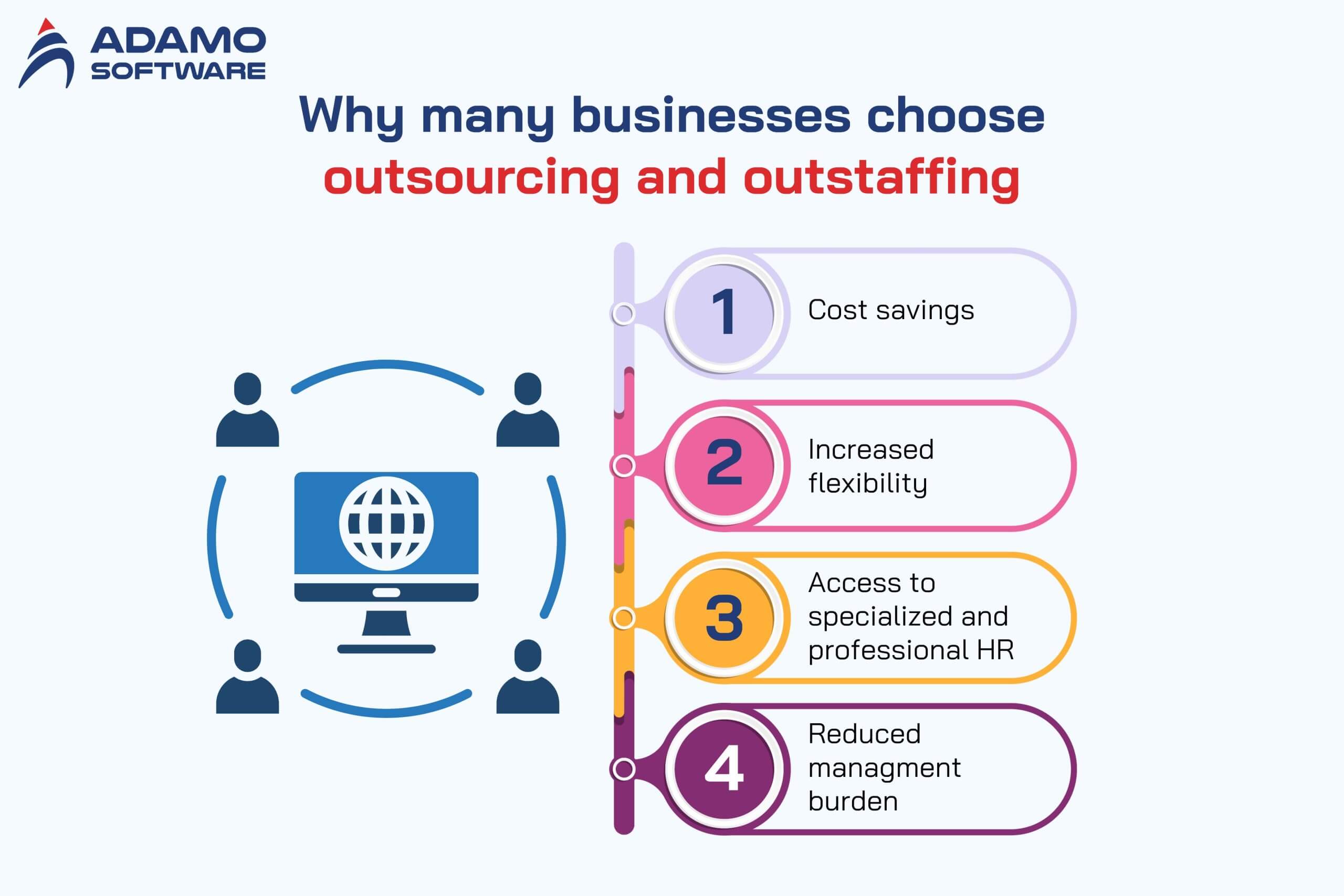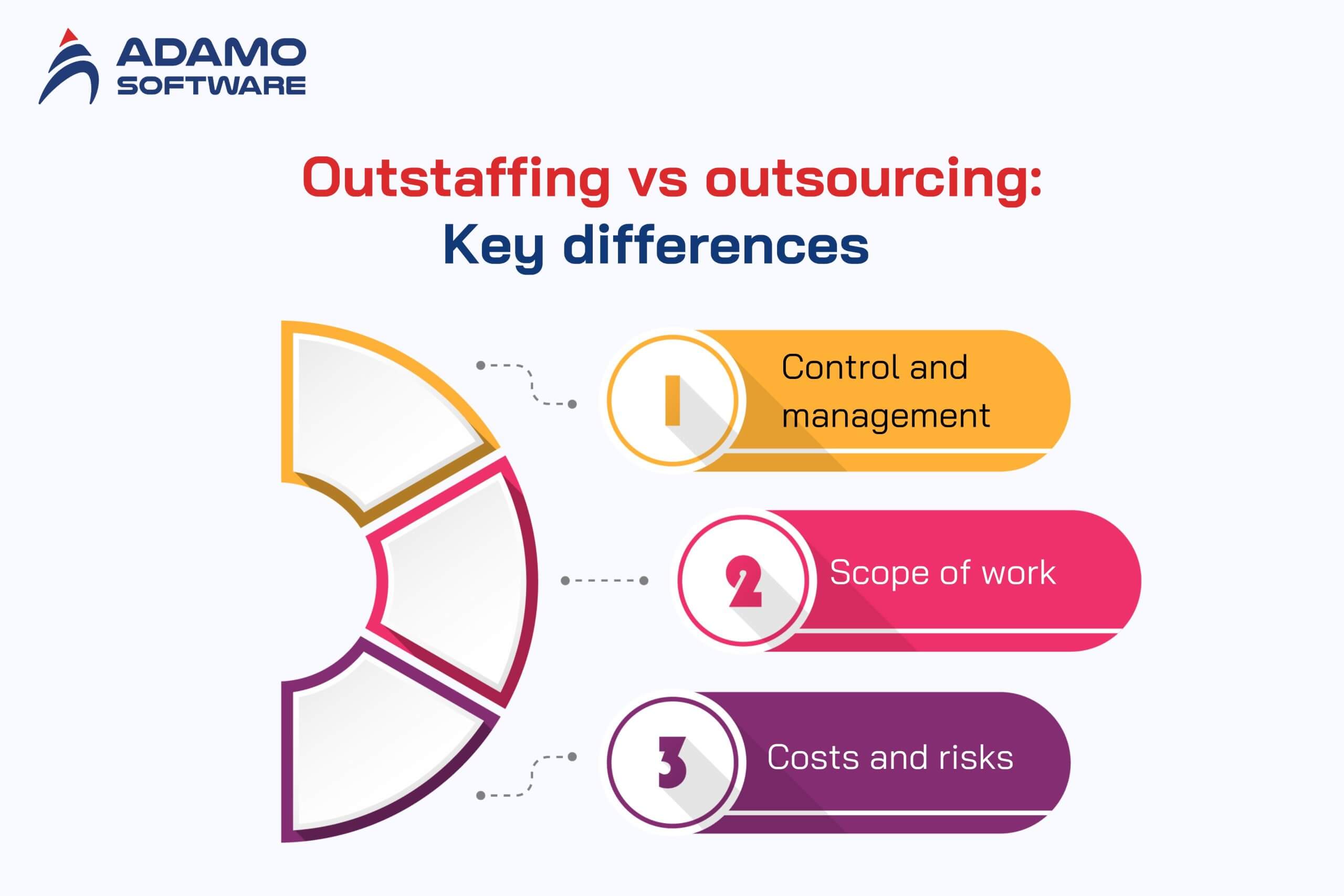Outstaffing vs outsourcing: What is better for your business?

In recent years, businesses tend to prioritize using labor outsourcing services to perform part or all the work of a department in the company. Accordingly, to streamline the business structure, companies will hire labor from a third party to handle the work.
Outstaffing vs outsourcing are two popular models for optimizing staffing and processes. Although they all provide external resources, they are different in the way they manage and work with employees. Choosing between outstaffing and outsourcing depends on the specific technical and other requirements and project scale. Let’s learn about these two models with Adamo Software!
Through this blog post, you will get more insights into outstaffing and outsourcing and their pros and cons. Besides, their differences and the reasons why many businesses choose these two models are also discussed. Moreover, you will also know how to choose the right model for your business. All information has been carefully researched and updated to the latest trends. So, let’s read our blog post and find some useful information!
I. Outstaffing vs outsourcing: What are they?
Outstaffing vs outsourcing, which one is suitable for a firm? This question is increasingly being asked by many businesses. Each method has its own approach to using external resources to support business operations. Before getting a better understanding of their differences, it is a must to grasp the specific definition of each model and its advantages and disadvantages. Let Adamo Software discuss these two concepts in detail.
1. What is an outstaffing model?

The outstaffing model allows businesses to hire human resources from a third party but still retain direct control and management of that team. Outstaffing requires the business to have its process and happens when the business needs someone to replace or supplement a certain task in that general process.
Thanks to the third party’s personnel, the company can operate flexibly, especially when it needs to scale up and expand its market. This is a great way to shorten the time and reach the top of the market quickly. Instead of having to plan, build a recruitment process, find candidates, filter profiles, etc., the firm just needs to hire a third party to handle all the above tasks.
The company’s job now is to focus on expanding its customer base and allocating new personnel appropriately. Despite hiring personnel from a third party, the company still retains direct control and management of human resources and the operation process. Businesses can regulate and monitor the daily work of employees. The outstaffing often offers greater flexibility and helps businesses maintain close ties with their workforce. This is one of the differences between outstaffing vs outsourcing, which will be discussed in more detail in the next sections.
2. Pros and Cons of outstaffing
Before drawing a conclusion about which is better, outstaffing vs outsourcing, it is important to understand the advantages and disadvantages of each method. Let Adamo Software discuss the pros and cons of outstaffing first.
The advantages of the outstaffing
The outstaffing model brings many outstanding advantages to businesses. First, businesses will have the right to control employees or teams. Although they hire employees from a third party, these employees are still subject to their supervision, which ensures the tasks are performed according to requirements and standards.
Secondly, the outstaffing model allows businesses to optimize their human resources costs. Thanks to the outstaffing team, companies hire fewer full-time employees. Thus, they can cut down the costs of taxes, salaries, and other related costs. Businesses can easily adjust team size based on actual project needs.
Last but not least, businesses can hire highly skilled professionals without investing time and money in training, improving work efficiency quickly and effectively. External experts can strengthen project teams and help achieve set KPIs faster and more effectively. Overall, when compared to outstaffing vs outsourcing, this model offers greater flexibility and control for businesses.
The disadvantages of the outstaffing
While the outstaffing model offers many benefits, there are also some notable disadvantages. Managing a remote team can lead to difficulties in communication and coordination, especially if there are language or cultural differences. If the staff is from another country, the time zone difference can make it difficult to make phone calls. This can lead to delays in getting work done.
Additionally, if the company does not choose the right service provider, it may encounter problems with the quality of work. This can affect the progress and efficiency of the project. When comparing outstaffing vs outsourcing, businesses need to consider these disadvantages to make the right decision for their operating model.
3. What is an outsourcing model?
Outsourcing occurs when a business pays an outside vendor to provide goods and services, rather than performing the work in-house. Instead of managing and performing internal tasks, businesses will require an outside unit to perform tasks like manufacturing, software development, customer service management, etc. The type of outsourcing depends largely on the needs of the business and the industry in which they operate. The most common outsourcing activities include marketing, supply chain management, human resource management, accounting, tax, training management, etc.
Thanks to this convenience, businesses can focus on core operations and save costs. However, this model can also lead to a loss of control over quality and processes. When considering outstaffing vs outsourcing, the outsourcing model often offers convenience and cost-effectiveness, but businesses also have to analyze the risks involved.
4. Pros and Cons of outsourcing
When comparing outstaffing vs outsourcing, the outsourcing model is often chosen when businesses want to save costs and focus on core activities. However, outsourcing also has disadvantages that businesses need to consider. Let’s find out the pros and cons of outsourcing with Adamo Software!
Advantages of outsourcing
The most visible advantage of outsourcing is cost savings. You can get your work done at a lower cost and with better quality. When outsourcing, you can easily avoid the time, money, and energy required to hire employees. Instead of interviewing countless candidates or waiting to hire the right person, you can handle the problem yourself. Besides, one of the most beneficial aspects of outsourcing is that you can choose a company or team that specializes in a specific area, skill set, or knowledge. This increases efficiency for your company’s projects. Additionally, outsourcing your business processes allows you to focus on building your brand, investing in research and development, and providing higher-quality services.
Disadvantages of outsourcing
One of the biggest disadvantages of the outsourcing model is that you may lose control over the work process. This leads to difficulty in ensuring product or service quality. To ensure quality work, you should clearly outline the goals that the service provider must meet. Besides, you must have regular meetings and reviews so that both parties are satisfied during the outsourcing process.
Additionally, sharing sensitive data and information with third parties can pose security risks, especially if the partner does not have a strong security policy. Thus, you must increase security to mitigate the risks if you choose outsourcing.
Overall, outsourcing can cause difficulties if not done properly or if the right provider is not chosen. When comparing outstaffing vs outsourcing, it is clear that businesses need to carefully consider these risks to choose the right model.
Also read: Dedicated development team vs outstaffing: What’s the difference?
II. Why many businesses choose outsourcing and outstaffing
Outstaffing vs outsourcing, no matter which method is better, many businesses choose these two types for their common benefits. Here are the same benefits they offer.

1. Cost savings
Both models help businesses reduce costs related to recruitment, training, and employee benefits. Instead of investing in long-term internal human resources, businesses can use external resources to optimize their budget.
2. Increased flexibility
Both outsourcing and outstaffing provide high flexibility in adjusting the size of human resources. Businesses can easily expand or reduce their team based on the actual needs of the project without having to commit to long-term recruitment.
3. Access to specialized and professional human resources
Another important benefit is that both models allow businesses to access skilled and experienced professionals without going through a complicated recruitment process. Outstaffing vs outsourcing, thanks to these two models, companies can have new ideas to improve their performance and efficiency. Besides, outsourced staff will ensure work deadlines are met, promoting work efficiency.
4. Reduced management burden
Both models in outstaffing vs outsourcing help reduce internal management pressure, bringing higher operating efficiency. When businesses adopt one of them, they do not need to invest too much time and effort in managing daily human resource activities. These activities include recruiting, training, monitoring, or dealing with welfare-related issues. This allows businesses to focus on strategic activities and core business development without being overwhelmed by complex administrative tasks.
For example, by outsourcing services such as IT, customer care, or accounting, a business can devote internal resources to core activities such as product research and development.
Overall, both outstaffing and outsourcing offer significant benefits in terms of cost, flexibility, and access to expertise. However, choosing which model is right for your business depends on the specific situation and project requirements.
To optimize efficiency, businesses need to carefully consider factors such as level of control, confidentiality, and cost before deciding on outstaffing vs outsourcing.
III. Outstaffing vs outsourcing: Key differences
When considering outstaffing vs outsourcing, there are some important differences to note so that you can choose the right model. While both are forms of outsourcing, the management and role of the business in each model are significantly different. Let Adamo Software discuss the key differences between outstaffing and outsourcing.

1. Control and management
In comparing outstaffing vs outsourcing, control, and management are among the most important differences. With the outstaffing model, the business retains direct control over the outsourced workforce. The staff will work under the direction of the business, following the company’s established work processes and standards. This makes it easy for the business to monitor work progress and adjust when necessary.
In contrast, in outsourcing, the business transfers all the responsibility of the work to an external partner and does not interfere with the day-to-day implementation process. The service provider will manage the team and be responsible for the final result, but the business will lose detailed control over progress and quality. Therefore, the choice between outstaffing vs outsourcing will depend on the level of control the business wants to maintain in its projects.
2. Scope of work
The scope of work is also among the differences when comparing outstaffing vs outsourcing. While in the outstaffing model, businesses often hire staff for the long term or for tasks related to internal processes, outsourcing is mainly applied to short-term tasks or projects. Detailed information about each model is as below.
Outstaffing
In the outstaffing model, the scope of work typically includes tasks and projects that require ongoing involvement and close coordination with internal departments of the business. Some specific tasks include developing products or software, maintaining and upgrading systems, managing data, optimizing workflow, and supporting in-house engineering. The scope of work in outstaffing is often flexible and can be adjusted based on the needs of the business, helping to increase work efficiency and maintain quality without having to hire full-time. When comparing outstaffing vs outsourcing, it can be seen that outstaffing focuses more on internal participation and control.
Outsourcing
In the outsourcing model, the scope of work typically includes non-core tasks or projects that the business decides to transfer to a third party. These tasks are usually short-term or temporary and do not require deep involvement from the business. Specifically, they are customer care service, IT management, finance and accounting, and marketing. When comparing outstaffing vs outsourcing, it can be seen that outsourcing allows businesses to completely delegate responsibility to an external partner, while outstaffing still maintains control and oversight of operations.
3. Costs and risks
In the context of outstaffing vs outsourcing, cost and risk are two important factors that businesses must consider when choosing the right model. Regarding the costs, an outstaffing model may cost more as the businesses still have to manage the working process themselves. Although businesses can save costs in recruiting and training, they still need to invest in management tools and processes to ensure work efficiency. Whereas the outsourcing model often helps businesses save further costs by transferring all responsibilities to a third party.
In terms of the risks, if an organization chooses the outsourcing model, it will lose control over the quality and progress of the work. If the partner fails to meet the requirements, this can seriously affect the business operations. Whereas with the outstaffing model, businesses will face management risks. Without close supervision, it can result in the outstaffing employee not performing the required work.
In general, when comparing outstaffing vs outsourcing, businesses must carefully evaluate the costs and risks associated with each model to make the most appropriate decision for their needs and development strategy.
IV. Outsourcing vs Outstaffing: Tips to Choose the Right Model for your business
When deciding between outstaffing and outsourcing, businesses must consider many factors to choose the model that suits their needs and goals. Below are some tips for choosing the right model for your business.

1. Identifying the goals and requirements of the projects
Firstly, your business must identify clearly the goals and requirements of the projects. When choosing between outstaffing and outsourcing, this is extremely essential. If your company’s project requires constant interaction and close control, the outstaffing will be an ideal choice. Whereas, if the work is non-core and can be delegated to a third party, outsourcing will help the business save time and costs.
2. Evaluating the costs and budget
It is also important to evaluate the costs and budget. While outstaffing may cost more, outsourcing helps you save on management costs. Businesses must calculate in detail to choose a model that fits their budget and performance expectations.
3. Considering the complexity of the project
If the work requires highly specialized skills and is related to the core operations of the business, outstaffing will bring greater benefits. However, if the work is simple and standardized, outsourcing will be a reasonable choice to reduce the management burden.
4. Checking the reliability of the partner
If a business chooses to outsource, finding a reliable partner is very important. Businesses need to consider the partner’s experience, reviews from previous customers, and ability to provide quality services to ensure they can meet the requirements and standards.
5. Risk analysis
Businesses need to analyze the risks associated with both models. Outstaffing can help maintain control but can cause problems if not properly monitored. Conversely, outsourcing can cause risks of losing control over data quality and security. Understanding these risks will help you make smarter decisions.
In general, choosing between outsourcing vs outstaffing depends on budget and job requirements. Besides, you also need to consider many different factors to ensure the chosen model best suits the long-term goals of the business.
V. Outsourcing software development and outstaffing with Adamo Software

No matter if you choose between outstaffing vs outsourcing, Adamo can help you all. As one of Vietnam’s leading companies in technology and software outsourcing, we can provide safe, flexible, and effective solutions for your business. When choosing Adamo, you can believe in our dedicated development team model. With this model, we will have a development team working exclusively on corporate projects, helping to ensure continuity and consistency in work.
Besides, our team can deeply integrate into the business workflow, gain a better understanding of specific needs and requirements, and thereby improve project efficiency. If you want, you can adjust team members based on project needs and progress, increasing flexibility during development.
Last but not least, our dedicated team is available to support your firm at every project stage, from initial idea to implementation and maintenance.
Overall, outsourcing software development and outstaffing with Adamo Software can help you save time and costs and improve product quality through a dedicated development team. Still hesitating whether to choose Adamo Software? Let’s contact our team and we will answer all your questions.











